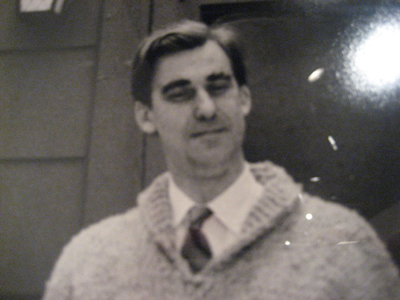Berkeley was not without murals before Stefen took brush to the Dutch Boy wall in January 1974, but the murals we had were conventional, mainstream, highbrow art.
One of the oldest murals in Berkeley is rarely seen. It is found at the Berkeley Piano Club, 2724-2726 Haste. The club is what it sounds like, and is still active. Both Internationally known and aspiring pianists have performed here.
This clipping from the Gazette tells us that the mural was painted for a 1923 Russian musical.
There also was the 1936 mural in the old gym at Berkeley High, now demolished.

Photo courtesy BUSD. http://www.berkeleyside.com/2012/06/28/historic-berkeley-high-old-gym-makes-way-for-the-new/
These are lovely pieces in a fine-art tradition.
Speaking of fine art – how about our one Diego Rivera?
Diego Rivera’s “Still Life and Blossoming Almond Trees,” is found in Stern Hall on the Cal campus.
It was painted in the Atherton home of Rosalie Stern in 1931 and moved to Stern Hall in 1956.
In 1892, Rosalie Meyer married Sigmund Stern, the president of Levi Strauss and Company. She was a civic and social leader of San Francisco – think Stern Grove if nothing else. She had the money to hire Diego Rivera to paint a mural in her home.
The mural depicts three young children reaching into a basket of fruit. Behind them three men work with hand tools and a fourth drives a tractor. The young children are portraits of Rosalie Stern’s grandchildren, Rhoda, Peter, and Walter Haas.
It was restored in 1982 by Lucienne Bloch Dimitroff and Stephen Dimitroff, who assisted Rivera on murals in Detroit and New York,
It being the 1950s and our national moral panic about things Left being what it was, it was suggested to Chancellor Clerk Kerr that Diego’s Communist affiliations and “some social significance of the subject matter of the fresco” might render the mural too controversial a gift. Kerr almost scoffed at at the thought: “The subject matter is that of an orchard in bloom with Mrs. Stern’s grandchildren (I think) depicted at play in the orchard. I might add that Rivera’s murals are owned and exhibited at the California School of Fine Arts and the Stock Exchange in San Francisco.”
There are also the murals at the Post Office on Allston.
Suzanne Scheuer painted the mural for the Treasury Relief Art Project between 1936 and 1937. Scheuer was a fine arts major at the Claifornia College of Arts and Crafts and then studied mural painting with Ray Boynton at the California School of Fine Arts (now SFAI).
She also painted murals at Coit Tower and the Presidio in San Francisco.
She said this about the mural: “I believe, but, out of a clear sky, we were handed these Post Office jobs and I got the prize Post Office, it was really a scream, many artists would like to have had that job. I couldn’t get an idea for that mural. Couldn’t get an idea. And it was a very awkward shape [over the door to the Postmaster’s office] and the Postmaster did not want to move the clock. Oh, I can’t blame it on the Postmaster, really. I just didn’t have any inspiration ever, so that job dragged on. We were paid by the month for that and better than the WPA paid.”
The Berkeley Post Office mural, “Incidents in California,” depicts the earliest inhabitants of Berkeley.
Helen Bruton (painter, mosaicist and mural painter) and Florence Alston Swift (known for non-objective, flat inlays) made two murals on the eastern facade of what was the old Powerhouse just north of Sather Gate.
The top mural depicts music and painting, the bottom sculpture and dance. Bruton said: “We collaborated on the colors, of course, as best we could, and that was made of the same material as the Fleishhacker one, the rubbed down tile that was reduced in thickness and then cut up.”
Another mural in Berkeley before Stefen – Romare Bearden’s “The City and Its People,” painted in 1973, installed in the City Council chambers in 1974, since removed.

Photo: http://globalurbanhumanities.berkeley.edu/representing-our-urban-diversity-romare-beardens-berkeley-the-city-and-its-people
It is highbrow, fine art. It is not of the street.
Bearden was an established painter. His work addressed unity and cooperation within the African-American community. He was a founding member of the Harlem-based art group known as The Spiral, formed to discuss the responsibility of the African-American artist in the struggle for civil rights. He was the real deal, not a street artist.
And for this reason – the reason being that it is not of the street – I don’t include the murals of Jess Collins in the Oregon Street home of Pauline Kael, painted in 1956.
They were in a private home, not of the street. They are wonderful. I admire and celebrate them, but they are a different beast. Completely different.
I showed these photos to my friend. He hauled out a photo from a 2014 trip that he took to Tokyo. He was in a bar designed by Kengo KumIn in the Kichijoji suburb of Tokyo, The walls were covered with murals, and he incorporated his feelings there into his opinion about the old murals of Berkeley.






















